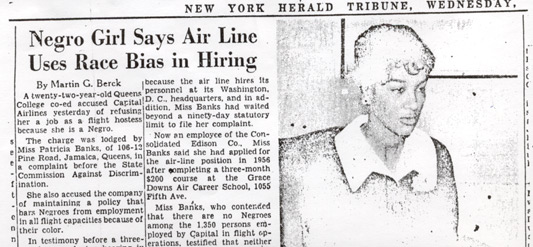In 1956, New York college student Patricia Banks counted herself among the first cadre of young black women to finish flight attendant training school. Sadly, like those other young women, she found it possible to gain employment with any of the major airlines, unlike her white classmates.
“…one of the chief hostesses from Capital [Airlines]…she saw me…she said, ‘Pat, I can’t see you go through this anymore.’ She said, ‘The airline does not hire Negroes.'” “It really never came to me that New York was just as racist as the South. I grew up when the South was having such terrible problems, but I had a thing inside of me…this just can’t be, not in New York!” “It was emotionally upsetting.” “But then I vowed, ok…you’re not gonna do this to us. I’m not gonna let you do this. And I decided that I was going to go with it all the way. I don’t care how long it took. And whether it was me that got hired, or somebody else, somebody was going to get hired.”
Ms. Banks sued, and in 1960, the New York State Commission against Discrimination ordered Capital Airlines (which merged with United a year later) to hire her, two years after Mohawk Airlines hired Ruth Carol Taylor as the first black flight attendant. But she knew that while the legal fight may have been over, the internal struggle was just beginning.
“I was very, very excited, very happy about it, but I also knew that it was going to be a challenge. … Because here I was, this black woman on this magnificent airline traveling all through the South, so I had to be … perfect. … I knew if I made any mistakes, they would be magnified and I would ruin the chance for other black people.”
See Ms. Banks’ entire interview below, then discover other black aviation pioneers at American Airlines‘ excellent Black History in Aviation website.

